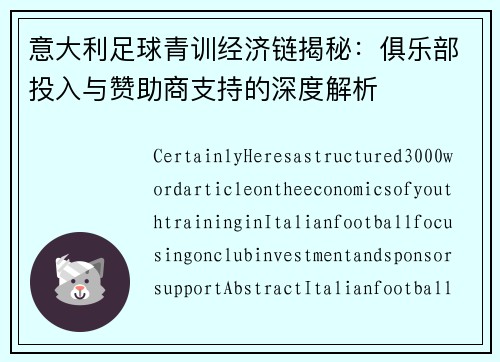Certainly! Here's a structured 3000-word article on the economics of youth training in Italian football, focusing on club investment and sponsor support.
**Abstract:**
Italian football's youth training system is a complex economic ecosystem where club investments and sponsorships play pivotal roles. This article delves into the intricate dynamics of this ecosystem, revealing how clubs invest in youth development while leveraging sponsorships to sustain and enhance their programs. By exploring funding sources, strategic partnerships, developmental strategies, and economic impacts, this article provides a comprehensive analysis of how Italy nurtures its footballing talent from grassroots to elite levels.
---
**1、Funding Sources**
Italian football clubs rely on diverse funding sources to support their youth academies. Central to this are direct investments from club revenues, which are earmarked specifically for youth development initiatives. These funds are crucial for maintaining facilities, hiring qualified coaches, and organizing training programs.
Additionally, government subsidies and grants play a significant role. These financial injections often target specific youth initiatives, encouraging clubs to meet certain developmental benchmarks in exchange for financial support.
Sponsorships constitute another vital funding stream. Companies eager to align with football's popularity and youth development goals often sponsor academy programs. These partnerships not only provide financial support but also offer branding opportunities and community engagement, further incentivizing clubs to invest in their youth setups.
2、Strategic Partnerships
Strategic partnerships are integral to the sustainability and expansion of Italian football academies. Clubs often collaborate with educational institutions to integrate academic and athletic development, ensuring players receive holistic education alongside their football training.
International partnerships are also pivotal. Italian clubs frequently form alliances with foreign academies, exchanging coaching methodologies and scouting networks. These collaborations broaden talent pools and expose young players to diverse footballing cultures.
Furthermore, partnerships with sports technology firms enable clubs to adopt cutting-edge training tools and analytics. These innovations enhance player development programs, providing data-driven insights that optimize training regimes and improve performance metrics.
BET365官网登录3、Developmental Strategies
Italian football clubs employ multifaceted developmental strategies to nurture young talent effectively. Talent identification begins at grassroots levels, with scouts scouring local leagues and tournaments for promising youngsters.
Once identified, selected players enter structured development pathways tailored to their age and skill levels. These pathways emphasize technical proficiency, tactical understanding, and mental resilience, ensuring players acquire comprehensive footballing skills.
Player welfare is paramount in these strategies. Clubs invest in sports psychology, nutrition, and injury prevention programs to safeguard young athletes' physical and mental well-being throughout their developmental journey.
4、Economic Impacts
The economic impacts of youth training reverberate across Italian football and beyond. Successful academy graduates often command substantial transfer fees when they move to senior teams or other clubs, injecting significant revenue into their parent clubs.
Moreover, youth development fosters a sense of identity and community pride, strengthening fan engagement and loyalty. This emotional connection translates into increased ticket sales, merchandise purchases, and sponsorship opportunities for clubs involved in robust youth programs.

On a broader scale, Italy's investment in youth football cultivates a steady supply of skilled players for the national team, enhancing its competitiveness in international competitions and bolstering the country's footballing reputation globally.
总结:
Italian football's youth training ecosystem thrives on a delicate balance of club investments and sponsor support. By strategically leveraging these resources, clubs sustain comprehensive developmental pathways that produce top-tier talent. This symbiotic relationship not only fuels the football economy but also fortifies Italy's position as a powerhouse in global football.
From grassroots scouting to international partnerships, every facet of this system contributes to Italy's enduring legacy of football excellence.
